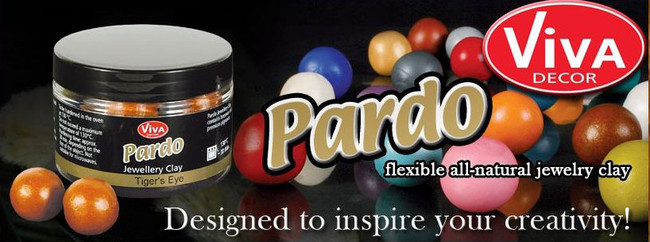
Compare Pardo Jewellery Clay to Pardo Professional Art Clay (including Pardo Mica Magic and Pardo Translucent Art Clays)
- Both contain pure beeswax and premium pigments
- All Pardo colors mix well together and with other polymer clay brands
- You can cane with Pardo Jewellery Clay but Pardo Professional Art Clay was formulated with cane work in mind for crisp clean lines.
- Pardo Jewellery Clay is very easy to condition. Pardo Professional Art Clay is a little stiffer for premium cane work
Don't let the name fool you!! Pardo Jewellery (european spelling) Clay is not just for jewelry making!
Check out this link to see how it bakes up: Click
Conditioning Pardo Clays -
"...it’s hard and crumbly and difficult to condition. It’s easy to assume that your clay has been partially cured or is old. But hold on! There is a trick to it. Pardo is not like other brands of polymer clay. Here’s how to condition Pardo Translucent Art Clay."
Please take a moment to read this great article at The Blue Bottle Tree. This technique works for all the lines including Pardo Jewellery Clay and Pardo Professional Art Clay.
EARTH FRIENDLY
Pardo clay is made with pure beeswax which enables it to be moldable.
There are no phthalates in Pardo Clay.
Pardo Polymer Clay
It is odorless before and after baking...read on...
There are 69 beautiful colors available in the Jewellery line.
Pardo is a patented polymer clay that has come to the US from Germany. It has been on the market there for about three years and is very popular. It has no phthalates and is made with beeswax and other natural ingredients.
Pardo bakes at the same temperature (266°) as many other polymer clays. It has no smell before or during baking. Note about baking. I have baked many Pardo items at 275° without any problems but I find the color shift is greater at the higher temperature and I have been told it is better to bake at 266° for strength reasons. Follow the temperature on the jar.
Pardo Jewellery Clay comes in 69 amazing colors, many with mica in them. You can mix it with other polymer clays. I am told it isn't affected by sunlight in the same way that other polymer clays are so there shouldn't be a problem with it curing before you have even opened the package.
Pardo needs little or no conditioning. You can run it through the pasta machine on the #9 setting, the thinnest setting, and after it is baked that thin it is still strong enough that you can tie it in a bow like a shoelace.
Pardo canes very nicely although if you are used to a stiffer clay for caning, I recommend Pardo Professional Art Clay. Canes have been made that were small enough to need a magnifying glass to see and the design was still there after reducing it that small. Also, when slicing, the design didn't smear. Lisa Pavelka loves it and you will see her signature advertising it.
One very happy customer's comments:
"I am finding that the Pardo is the only real reliable clay on the market. The only other brand that I liked was Studio and they stopped making it. It was as durable as Pardo; but, not as pretty baked as the Pardo."
Cheryl M. You can see some of Cheryl's clay work here.
Lisa Pavelka demonstrates Pardo Jewellery Clay on Fiskars TV
Pardo Professional Art Clay - 2 ounces
Click to see Pardo Professional Art Clay Experiments by Betty Jo Hendershott
You can mix the Art Clay with any of the Pardo Jewelery Clay!
Watch a great video of Lisa Pavelka
showing you how to use her products you can find here at Poly Clay Play.
- Pardo Art Clay
- Watch Parts
- Poly Bonder
- Tiny Tats
- MagicGlos Resin
- MargicGlos Resin Light
- Bezels












